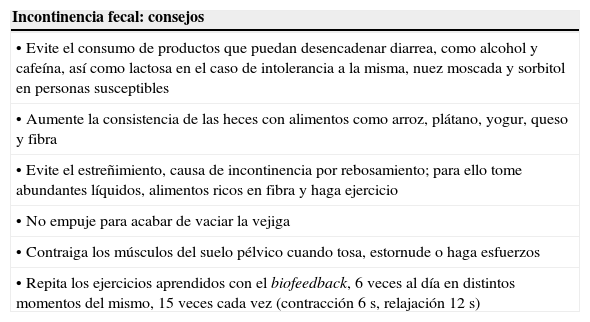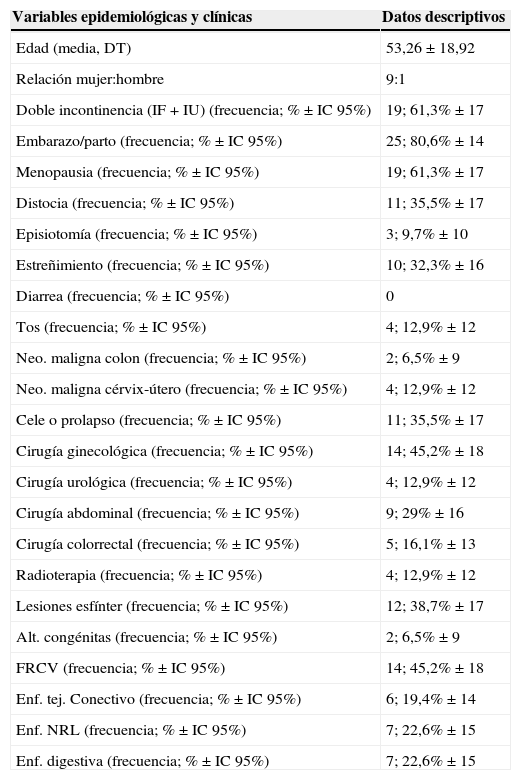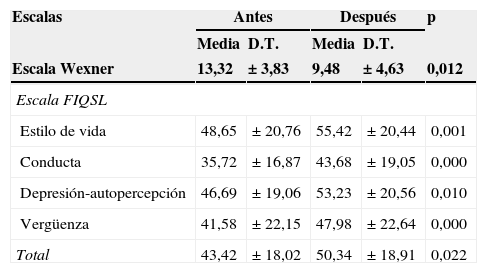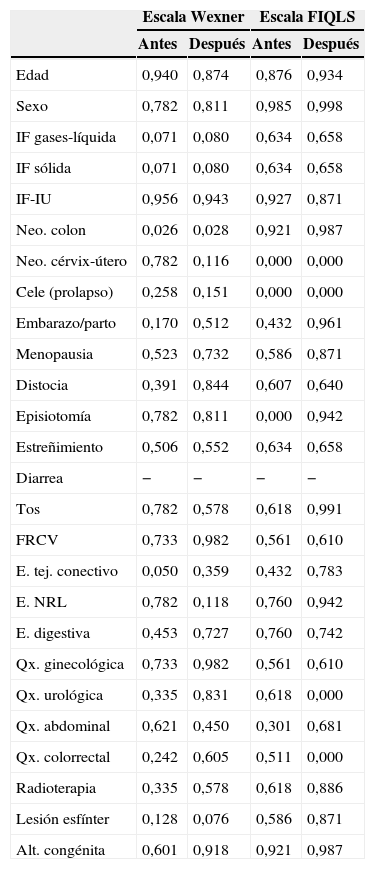La incontinencia fecal (IF) supone un problema clínico y social que afecta la calidad de vida (CV). Su tratamiento de elección es conservador, y el biofeedback el más recomendado.
ObjetivoConocer las variables clínicas/epidemiológicas asociadas con la IF y valorar la efectividad de un protocolo de tratamiento de electromiografía-biofeedback (EMG-BFB) con electrodos de superficie en la mejora de la CV.
Material y métodosEstudio prospectivo tipo antes/después en 31 pacientes con IF remitidos al Servicio de Rehabilitación de Salamanca entre 2008 y 2014. El tratamiento consistió en 20 sesiones de EMG-BFB bisemanales supervisadas por fisioterapeuta. Se realizó una valoración clínica y de la CV inicial/final con la escala/cuestionario de Wexner/FIQLS.
ResultadosEdad media 53años, género femenino 90,3% (ratio mujer/hombre 9:1). Los factores de riesgo más frecuentes son: historia obstétrica de embarazo/parto (80,6%), distocia (35,5%) y episiotomía (9,7%, p=0,000). Lesión de esfínteres (38,7%). Prolapso de órganos pélvicos (35,5%, p=0,000). Enfermedad del tejido conectivo (19,4%, p=0,05). Cirugía urológica (12,9%, p=0,000) y colorrectal (16,1%, p=0,000). Neoplasia asociadas: cérvix/útero (12,9%, p=0,000), colon (6,5%, p=0,026 antes, p=0,082 después). IF grave (67,75%), doble incontinencia (fecal y urinaria) (61,3%). La EMG-BFB mejora la CV significativamente en la escala Wexner y el Cuestionario FIQLS (p<0,05).
ConclusionesLa IF aumenta con la edad, prevalece en mujeres y se asocia fundamentalmente a historia obstétrica de embarazo/parto. Se asocia significativamente con la episiotomía, enfermedades del tejido conectivo, cirugía urológica/colorrectal, neoplasias de cérvix/útero/colon y prolapso de órganos pélvicos. La EMG-BFB constituye una técnica efectiva de tratamiento en los pacientes con IF, al mejorar la clínica y todos los componentes de CV del cuestionario/escala FIQLS/Wexner.
Fecal incontinence (FI) is a clinical and social problem that affects health-related quality of life (QoL). The treatment of choice is conservative, with biofeedback being the most widely recommended.
ObjectiveTo determine the clinical/epidemiological variables related to FI and to assess the effectiveness of biofeedback with surface electrodes (EMG-BFB) in improving QoL in FI patients.
Material and methodsA quasi-experimental prospective before/after FI study was conducted in 31 patients referred to the Rehabilitation Service of Salamanca between 2008 and 2014. The intervention consisted of 20 sessions of EMG-BFB twice weekly, supervised by a physiotherapist. Clinical and before and after QoL assessment was performed with the Wexner/FIQLS scale/questionnaire.
ResultsThe mean age was 53 years, and 90.3% were women (female/male ratio, 9:1). Risk factors were an obstetric history of pregnancy/delivery (80.6%), dystocia (35.5%) and episiotomy (9.7%, P=.000), sphincter injury (38.7%), pelvic organ prolapse (35.5%, P=.000), connective tissue disease (19.4%, P=.05), colorectal (16.1%, P=.000) and urological (12.9%, P=.000) surgery. Associated neoplasms consisted of tumors of the cervix/uterus (12.9%, P=.000) and colon (6.5%, P=.026/P=.082). Severe FI was found in 67.75%, and double incontinence (fecal and urinary) in 61.3%. EMG-BFB significantly improved QoL in the Wexner/FIQLS Scale/Questionnaire (P<.05).
ConclusionsFI increases with age, is prevalent in women, and is associated specially with an obstetric history of pregnancy/delivery. FI is significantly associated with episiotomy, connective tissue disease, urological and colorectal surgery, neoplasms of the colon, uterus and cervix, and pelvic organ prolapse. EMG-BFB is effective in improving clinical symptoms and all components of QoL in patients with FI.














